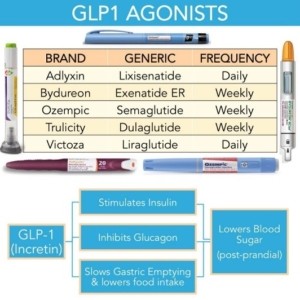The term “Ozempic face” has surged in popularity, racking up over 2.3 million views on TikTok and sparking countless discussions across social media. This buzzword describes facial changes observed in individuals experiencing significant weight loss, particularly those using medications like Ozempic. Coined by New York dermatologist Dr. Paul Frank, “Ozempic face” refers to the gaunt, sagging facial appearance reported by some patients on weight-loss drugs. While linked to Ozempic, a medication for diabetes, it’s crucial to understand that substantial weight loss itself is the primary driver behind these facial changes. So, is a more aged facial appearance an unavoidable trade-off for dramatic weight loss? For some, the answer is yes, as susceptibility varies among individuals.

The weight loss industry in the U.S. is booming, reaching a staggering $90 billion. This growth is significantly fueled by the emergence of prescription drugs known as GLP-1 agonists (including Ozempic, Wegovy, Rybelsus, Trulicity, Victoza, and Saxenda, containing semaglutide, dulaglutide, and liraglutide) and combination GIP/GLP-1 agonists (such as Mounjaro and Zepbound, containing tirzepatide). These medications have transformed the landscape of obesity and diabetes treatment, impacting the traditional diet industry. It’s estimated that approximately one in eight adults in the US has explored these medications for either weight management or diabetes control.
How Ozempic and Similar Medications Work
Ozempic, initially developed for type 2 diabetes, functions by mimicking the glucagon-like peptide-1 (GLP-1) hormone. This hormone plays a vital role in regulating blood sugar and slowing down digestion. By mimicking GLP-1, Ozempic reduces appetite and promotes weight loss. GLP-1, an incretin hormone produced in the gut, enhances insulin release from the pancreas, but only when blood sugar levels are elevated. This targeted mechanism minimizes the risk of hypoglycemia (low blood sugar), a common concern with many other diabetes medications.
Ozempic is part of a class of drugs that have become remarkably popular for their off-label use in weight loss. These medications facilitate significant weight loss, often ranging from 15% to 25% of body weight within 1 to 1.5 years.
- FDA-approved for diabetes treatment: Ozempic, Trulicity, and Mounjaro (administered via weekly injection, except Victoza, which is daily). Rybelsus is an oral semaglutide GLP-1 agonist for daily diabetes management.
- FDA-approved for weight loss: Wegovy (weekly injection of semaglutide) and Saxenda (daily injection of liraglutide) are specifically approved for weight loss. Zepbound (weekly injection of tirzepatide) is a GIP/GLP-1 agonist also approved for weight management.
These medications are indicated for weight management in adults with obesity (body mass index [BMI] ≥ 30) or overweight (BMI ≥ 27) who also have at least one weight-related health condition, such as hypertension, type 2 diabetes, or high cholesterol.
“Ozempic Face” Explained: Rapid Weight Loss and Facial Changes
The phenomenon of “Ozempic face” isn’t exclusive to Ozempic; it’s a consequence of widespread fat loss throughout the body due to significant weight reduction from any method. Because Ozempic and similar drugs are highly effective in promoting weight loss, the resulting facial changes can be more pronounced, leading to the popular term “Ozempic face.” Noticeable facial fat changes typically appear after losing 25 to 30 pounds, but this can vary based on individual factors like starting weight, height, and facial fat distribution.
Facial fat pads are crucial for maintaining facial structure and volume, contributing to a youthful appearance. The loss of these fat pads leads to a hollowed appearance around the eyes, cheeks, and temples. This more skeletal and aged look is also a natural part of the aging process. Several factors can increase the likelihood of developing these facial changes, including older age (more common in middle-aged and older individuals) and reduced skin elasticity due to lifestyle factors (sun exposure, smoking), genetics, or inherent skin type. Individuals with fair skin, who often have thinner and less elastic skin, may be more prone to showing signs of “Ozempic face.”
Managing and Reducing the Risk of “Ozempic Face”
To address skin and facial changes associated with Ozempic and similar weight loss medications, consulting a dermatologist or healthcare provider for treatments like soft tissue fillers is recommended. The optimal time to consider facial volume restoration is typically after reaching your desired weight loss goal. Gradual dose reduction of weight loss medications, under medical guidance, can help prevent rebound weight gain once medication use is discontinued.
- Dermal Fillers: These are used to restore lost volume and create a fuller, more youthful facial appearance. Various FDA-approved dermal fillers can be injected into areas like the cheeks, chin, temples, and under-eye area. Choosing a licensed and experienced provider is crucial to minimize risks associated with fillers, which can include pain, tenderness, swelling, infection, filler migration, and more serious complications like vascular occlusion and tissue necrosis. Significant filler amounts may be needed to address overall facial volume loss. Besides Hyaluronic Acid fillers (like Restalyne and Juvederm), biostimulatory fillers such as poly-L-lactic acid (Sculptra) can stimulate collagen production, offering longer-lasting effects.
- Skin Hydration: Medical-grade skincare focused on skin hydration can support collagen production, enhance skin elasticity, and diminish the appearance of wrinkles. Moisturizers containing hyaluronic acid and retinoids are beneficial for improving skin hydration and texture. For post-menopausal women, estrogen supplements may be considered to help reduce wrinkles and skin sagging.
- Autologous Fat Grafting: This longer-term solution involves transferring fat from other parts of your body to the face and can be performed under local anesthesia.
- Energy-Based Skin Tightening: Treatments like radiofrequency microneedling, Ulthera, or Softwave can be effective, particularly for younger patients with better skin elasticity.
- Surgical Treatment: Procedures such as brow lifts, blepharoplasty (eyelid surgery), partial or full facelifts, and neck lifts may be necessary to address loose skin in older individuals or those with more pronounced facial sagging and aging.
- Reducing the Risk of “Ozempic Face”: Aiming for a gradual weight loss of 1 to 2 pounds per week can give the skin more time to adapt to changes and potentially lessen facial volume loss. Working closely with your healthcare provider to ensure adequate nutrition is essential. Consider a multivitamin with iron and Vitamin D and increase protein intake to minimize lean body mass loss and reduce the risk of hair shedding (telogen effluvium). Medication dosage should be titrated monthly or as needed. GLP-1 agonists often induce a feeling of fullness quickly, reducing cravings. Incorporating strength training exercises can help maintain basal metabolic rate and lean body mass while on these medications.
Conclusion
Managing obesity and promoting effective weight loss are increasingly important health priorities. New medications, including GLP-1 agonists and combination GIP/GLP-1 agonists, are highly effective tools for treating diabetes and clinical obesity. Furthermore, the “off-label” use of these medications has demonstrated benefits in improving conditions linked to insulin resistance (like PCOS), resolving prediabetes, and achieving significant weight loss. For healthcare providers prescribing these medications, it’s vital to properly counsel patients on managing their weight loss journey. Ongoing research, the development of novel triple combination agonist drugs, and oral formulations of these potent weight loss medications offer promising benefits for many individuals struggling with obesity. As with any medication, it’s crucial to carefully consider both the benefits and potential side effects. Educating patients about potential side effects, including “Ozempic face,” empowers them to manage any concerning changes effectively, enabling them to achieve weight loss while prioritizing their skin health.
Further Reading:
- https://www.americanboardcosmeticsurgery.org/procedure-learning-center/non-surgical/injectable-fillers-guide/
- Blackburn GL, Bistrian BR. Hair loss with rapid weight loss. Arch Dermatol. 1977;113(2):234.
- Kobren SD. Misuse of Ozempic for Rapid Weight Loss Can Cause Significant and Perhaps Permanent Hair Loss. Derm Times. May 14, 2023.
- Busko M. Does Ozempic Cause Hair Loss? Medscape Dermatology. May 25, 2023.
- https://www.medscape.com/viewarticle/992377?form=fpf
- https://www.msn.com/en-us/health/other/what-is-ozempic-face-4-doctors-explain-the-buzzword-and-the-misconceptions-behind-it/ar-BB1pTwCS
- https://www.today.com/health/ozempic-face-rcna67737
- Comparing Ozempic, Wegovy and Other GLP-1 Drugs – GoodRx [Internet]. [cited 2023 Apr 24]. https://www.goodrx.com/classes/glp-1-agonists/glp-1-drugs-comparison
- Tayag Y. Ozempic Is About to Be Old News [Internet]. The Atlantic. 2023 [cited 2023 Apr 22]. Available from: https://www.theatlantic.com/health/archive/2023/04/ozempic-wegovy-mounjaro-weight-loss-drug-development-access/673627/
- LaRose. U.S. Weight Loss Industry Grows to $90 Billion, Fueled by Obesity Drugs Demand. MarketResearch.com
- https://blog.marketresearch.com/u.s.-weight-loss-industry-grows-to-90-billion-fueled-by-obesity-drugs-demand
- Karam, J. Nathan. A Review of FDA-Approved Medications for Chronic Weight Management. Drug Tropics. Aug 5, 2021.
- https://www.drugtopics.com/view/a-review-of-fda-approved-medications-for-chronic-weight-management
- Obesity and overweight. CDC. Updated March 1, 2021. Accessed June 24, 2021. https://ww.cdc.gov/nchs/fastats/obesity-overweight.html
